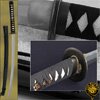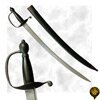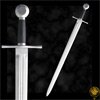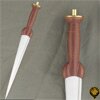|
|
|
PRODUCTS MANUFACTURED BY:
|
|
|
|
|
|
|
|
|
|
|
 |
|
| Hanwei Practical Wakizashi (SH2061) |
Points: 8

|
Now available to match the ever-popular Practical Katana (SH1070) is the Practical Wakizashi, offering the same quality at a great price. Blades are forged and differentially tempered to producing an HRC60 edge and HRC40 back. The temper line is authentic and prominent. Cost savings are effected by using fittings which, while making no claims to authenticity, are very strongly built to withstand the rigors of cutting exercises.
Hand-forged blade
Differential tempering
Fully functional
|
|
|
|
|
|
 |
|
| Hanwei Practical XL Katana - 28,5 inch (SH6000XPF) |
Points: 16

|
The blade is forged and differentially tempered, using the same process as the more expensive blades and producing an HRC60 edge and HRC40 back. The temper line is authentic and prominent. Cost savings are effected by using fittings which, while making no claims to authenticity, are very strongly built to withstand the rigors of cutting exercises in the dojo.
Forged high-carbon steel blade
Differential tempering
Hanwei made
|
|
|
|
|
|
 |
|
| Hanwei Raptor Shinogi Zukuri Katana (SH2414) |
Points: 16

|
The Raptor Shinogi-Zukuri blade, which has evolved as the most common Japanese katana blade design, provides both speed and cutting power. Featuring a distinct yokote, such blades were originally produced after the Heian period, around 987 AD.
The blade of the Raptor katana is hand forged in 5160 high carbon steel and is specifically heat treated to produce very high resilience and greater tolerance to misdirected cuts than a conventionally differentially tempered blade.
The blade geometry is configured to facilitate the cutting of both soft and semi hard materials without chipping, allowing the user a wider range of targets.
Cotton wrapped tsuka.
Tsuba, fuchi and kashira features a beautiful Raptor motif.
Black matte finish wood saya.
Comes with black sword bag.
|
|
|
|
|
|
 |
|
| Hanwei Raptor Shobu Zukuri Katana (SH2417) |
Points: 15

|
The Raptor Shobu-Zukuri (Iris Leaf) blade has an elegant shape and powerful cutting ability. Notable for the absence of a Yokote transition, this blade design became popular during the Nanbokucho era (1336 ~1392 AD) and its popularity continued into the Muromachi period.
The blade of the Raptor katana is hand forged in 5160 high carbon steel and is specifically heat treated to produce very high resilience and greater tolerance to misdirected cuts than a conventionally differentially tempered blade.
The blade geometry is configured to facilitate the cutting of both soft and semi hard materials without chipping, allowing the user a wider range of targets.
Cotton wrapped tsuka.
Tsuba, fuchi and kashira features a beautiful Raptor motif.
Black matte finish wood saya.
Comes with black sword bag.
|
|
|
|
|
|
 |
|
| Hanwei Raptor Tanto (SH2423) |
Points: 10

|
While the Wakizashi and Tanto of the Raptor series provide matching pieces for any of the Raptor katanas, they are in their own right designed as very effective cutting tools.
|
|
|
|
|
|
 |
|
| Hanwei Raptor Wakizashi (SH2422) |
Points: 23

|
While the Wakizashi and Tanto of the Raptor series provide matching pieces for any of the Raptor katanas, they are in their own right designed as very effective cutting tools.
|
|
|
|
|
|
 |
|
| Hanwei Renaissance Style Swept Hilt Rapier (SH1024) |
Points: 12

|
Our Renaissance-style Swept Hilt Rapiers trace their origins to early 17th century Europe, where swordplay with the Rapier was considered an essential part of a gentleman's education and was often used in resolving gentlemanly disagreements. Blades generally originated in one of the blade making centers such as Toledo or Solingen, but many differences in styling and hilt materials resulted from the local manufacture of hilts all over Europe. The Main Gauche, or left hand dagger, was often used with the rapier, providing an added dimension in both offense and defense, and the "Schools of Fence" which proliferated in Europe during this period taught the use of the two weapons in combination. The Main Gauche would often match the Rapier in styling, while incorporating features which maximized the effectiveness of the piece.
|
|
|
|
|
|
 |
|
|
|
|
 |
|
| Hanwei Revolutionary War Hanger (SH2375) |
Points: 13
|
Based on an original of the period, our Revolutionary War Hanger (or Cutte) is accurately sized and antiqued to replicate a museum piece. The fully tempered, blunt edged, high carbon steel blade has a distal taper, with fullers on both sides along the spine, and is light and quick. The hilt fittings are cast in solid steel, matching the locket and chape of the leather-covered scabbard.
|
|
|
|
|
|
 |
|
| Hanwei River Witham Sword (SH2372) |
Points: 11

|
The River Witham Sword was dredged from the River Witham near the town of Lincoln during work carried out in 1788. The sword may be a remnant of the Battle of Lincoln in 1141; however, it was most likely constructed between 1250-1300 CE. The inscription on the blade reads +NDXOXCHMDRCHDXORVI+. Iberia Swords are crafted in much the same way as swords were made centuries ago, except that the blades are now forged from high-carbon spring steel, a resource unavailable off-the-shelf to the smiths of the old. The blade finish is far from being polished, again more closely replicating what the medieval swordsmith was able to achieve. Except as noted, grips are leather-covered hardwood. Fittings are either steel or solid brass. Except, where shown all of these swords have scabbards of leather-covered wood with steel lockets and chapes and removable suspension rings. These swords will appeal to the re-enactor who wants a sword with the same appearance as the originals.
|
|
|
|
|
|
 |
|
| Hanwei Saxon Sword 9th century (SH2436) |
Points: 25

|
CAS Hanwei’s smiths have outdone themselves with their recreation of a 9th Century Saxon sword by replicating a technique used by the Saxons and Vikings and producing a stunning blade that features a pattern-welded core with high-carbon edge sections. This technique was used by the old-time smiths as a means of producing blades (just for the rich folks) that were sharp, resilient and decorative and, eleven hundred years on, CAS Hanwei has made them affordable.
The sword’s design is based on a 9th Century piece found in the bank of a stream in England in 1976 and now on display in the Yorkshire Museum.
|
|
|
|
|
|
 |
|
| Hanwei Scottish Basket Hilt Backsword (SH2003) |
Points: 24
|
Early highland swords almost invariably carried the double-edged "broadsword" blade, but by the time of the Battle of Culloden (1746) the single-edged "backsword" was at least equal in popularity.Our Basket-Hilt Backsword, replicated from an original in the collection of the Royal Armouries in England that dates from about 1760, has an unusual basket with twin engraved "horned beastie" plaques and a blade with twin fullers running most of its length. The blade is German in origin, but the hilt and blade are contemporary.
|
|
|
|
|
|
 |
|
| Hanwei Scottish Court Sword (SH1214) |
Points: 12

|
Quick and elegant describe the Scottish Court Sword. Replicating an original dating from the 1730's and belonging to an officer in Prince Charles Edward Stuart's army at Culloden, the finely chiseled silver-plated hilt and three-edged hollow ground blade exemplify the consummate skill of the swordsmiths of the period. See model SH2324 for the Practical Fencing Court Sword.
|
|
|
|
|
|
 |
|
| Hanwei Scottish Dirk (SH2363) |
Points: 8
|
The ever-popular Early Dirk is strikingly authentic, its clean lines and carved hardwood hilt making it a clansman re-enactor favorite. Iberia Swords are crafted in much the same way as swords were made centuries ago, except that the blades are now forged from high-carbon spring steel, a resource unavailable off-the-shelf to the smiths of the old. The blade finish is far from being polished, again more closely replicating what the medieval swordsmith was able to achieve. Except as noted, grips are leather-covered hardwood. Fittings are either steel or solid brass. Except, where shown all of these swords have scabbards of leather-covered fiberglass with steel lockets and chapes and removable suspension rings. These swords will appeal to the re-enactor who wants a sword with the same appearance as the originals.
|
|
|
|
|
|
 |
|
| Hanwei Side Sword (SH2203) |
Points: 14
|
The Side Sword was a military sword of the 16th and 17th century Renaissance period that also achieved popularity among civilians, due to its relatively light weight and quickness. It also had an advantage over its contemporary, the rapier, in having the ability to cut efficiently as well as thrust. Side swords were often the weapon of choice for sword and buckler fighting. Our side sword, based on a German original, is a beautifully proportioned piece that balances very well. The "swept" hilt affords excellent hand protection and the blade geometry makes for outstanding performance in both the cut and the thrust.
|
|
|
|
|
|
|
Tags:
martial arts, katana, iaito, sword, fencing, tonfa, boken, bokken, kama, shinai, samuraj, judo, karate, kenjutsu, kenjitsu, ninja, kungfu,
|













